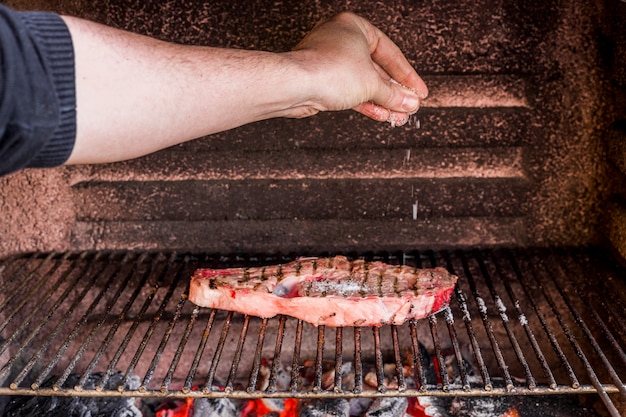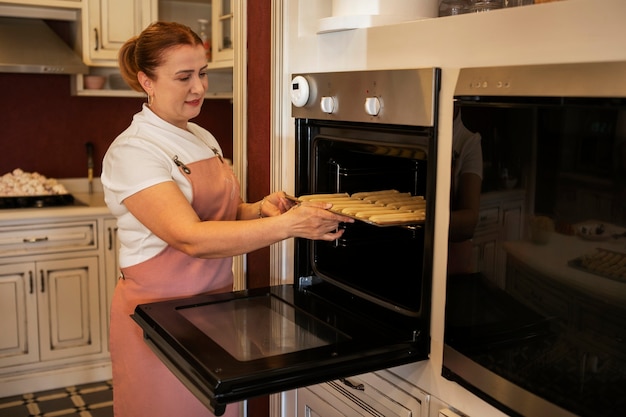(Part 1) choosing the right cut: Setting the Foundation for Success

The steak selection: A Foundation of Flavor
Before we get started, you need to choose the right cut of meat. I’m not going to overwhelm you with a fancy list of steak names; we’ll keep it simple. For oven cooking, you want a cut that can handle the heat and deliver a consistently delicious cook. Here are a few of my top picks: Rib-eye: A classic for a reason, rib-eye is known for its beautiful marbling and rich flavour. It’s versatile, working well for both medium-rare and medium doneness. Sirloin: A robust alternative, sirloin is a leaner cut compared to rib-eye, but still packs a punch in the flavour department. It’s a fantastic choice if you prefer a steak with a bit less fat. flank steak: While tougher than rib-eye or sirloin, flank steak boasts a delightful flavour and cooks up beautifully when marinated. It’s a perfect cut for slicing thinly and serving in stir-fries or fajitas.Thickness Matters: Understanding the Impact of Steak Size
The thickness of your steak also plays a vital role in the cooking process. Thinner steaks cook more quickly, while thicker cuts require a longer cooking time. As a general rule, I always aim for a steak that’s at least 1.5 inches thick. This ensures there’s enough room for the internal temperature to cook evenly.(Part 2) Getting Ready: The Art of Steak Prep

Seasoning with Love: Elevating the Flavor Profile
Now that you’ve got your chosen steak, it's time to season it with love. I’m a big fan of simple seasoning – salt and pepper are all you truly need. But if you fancy experimenting, feel free to get creative with different herbs and spices. Just remember, a generous seasoning is key!Let it Rest: Allowing the Steak to Reach its Full Potential
Before sending your steak to the oven, it’s a good idea to let it rest at room temperature for about 30 minutes. This lets the meat come up to temperature, which helps it cook more evenly.(Part 3) Oven Steak cooking basics: Unveiling the Fundamentals

Setting the Stage: Preheating and Oven Temperature
Now we’re getting into the heart of the matter. Preheating your oven is absolutely crucial for a successful oven steak. I typically preheat to 400 degrees Fahrenheit (200 degrees Celsius), but you can adjust this depending on the thickness of your steak. Remember, a well-preheated oven ensures that the steak cooks evenly and efficiently.The Art of Roasting: Exploring Different Cooking Methods
There are two primary methods for cooking steak in the oven:1. Direct Roast: This method involves placing the steak directly on a baking sheet or roasting rack. It’s a straightforward and simple way to cook a steak, especially for thinner cuts.2. reverse sear: A more sophisticated technique, the reverse sear is worth trying if you crave a perfectly cooked steak with exceptional tenderness and juiciness. This method involves cooking the steak at a low temperature for a longer period, followed by a quick sear in a hot pan to create a delicious crust.(Part 4) Oven Steak Cooking Times: The Breakdown
The Chart: Your Guide to Oven Steak Cooking Times
Here’s where we dive into the specifics of cooking times. Remember, these are general guidelines, and the best way to ensure your steak is cooked to your liking is to use a meat thermometer.| Steak Thickness (Inches) | Rare (125-130°F) | Medium-Rare (130-135°F) | Medium (140-145°F) | Medium-Well (150-155°F) | Well-Done (160°F ) |
|---|---|---|---|---|---|
| 1 | 10-12 minutes | 12-14 minutes | 14-16 minutes | 16-18 minutes | 18-20 minutes |
| 1.5 | 15-17 minutes | 17-19 minutes | 19-21 minutes | 21-23 minutes | 23-25 minutes |
| 2 | 20-22 minutes | 22-24 minutes | 24-26 minutes | 26-28 minutes | 28-30 minutes |
Remember: Resting is Key
Once your steak reaches your preferred doneness, it’s absolutely vital to let it rest for at least 5-10 minutes before slicing and serving. This allows the juices to redistribute throughout the meat, resulting in a more tender and juicy steak.(Part 5) Oven Steak Techniques: Mastering the Art of Oven Steak Cooking
The Reverse Sear: A Step-by-Step Guide
Let’s delve deeper into the reverse sear. It’s a bit more involved than the direct roast, but trust me, the results are absolutely worth it. Here’s a step-by-step guide to help you master this technique:1. Low and Slow: Preheat your oven to 275 degrees Fahrenheit (135 degrees Celsius). Place your seasoned steak on a baking sheet or roasting rack. For a 1.5-inch thick steak, cook for 1 hour and 15 minutes. Adjust the cooking time based on the thickness of your steak.2. The Final Touch: Once your steak reaches the desired internal temperature, remove it from the oven and let it rest for 10 minutes. Heat a heavy-bottomed skillet over high heat. Add a tablespoon of oil to the skillet and allow it to heat up. Carefully place your steak in the hot skillet and sear for 1-2 minutes per side. This creates a beautiful crust and adds a touch of deliciousness.3. Rest and Enjoy: Remove your steak from the skillet and let it rest for another 5 minutes before slicing and serving.Direct Roast: The Quick and Easy Method
If you’re looking for a more straightforward approach, the direct roast is the way to go. Here’s how to make it happen:1. Preheating is Key: Preheat your oven to 400 degrees Fahrenheit (200 degrees Celsius). 2. On the Rack: Place your seasoned steak on a baking sheet or roasting rack. 3. Time to Cook: Cook the steak for 10-12 minutes per side for a 1-inch thick steak, adjusting the cooking time based on thickness. 4. Rest and Serve: Once the steak is cooked to your liking, remove it from the oven and let it rest for 5-10 minutes before slicing and serving.(Part 6) Oven Steak with a Twist: Exploring Creative Variations and Ideas
Oven Steak with a Flavour Boost: Adding a Touch of Excitement
Now let’s talk about adding some extra flavour to your oven steak. The possibilities are endless, so feel free to get creative! Here are a few ideas to inspire you: Garlic and Herb: Rub a mixture of minced garlic, fresh herbs like rosemary, thyme, and oregano, and olive oil onto your steak before cooking. This infuses the steak with a vibrant, aromatic flavour. Honey Mustard: For a sweet and tangy glaze, brush your steak with a mixture of honey and Dijon mustard during the last 10 minutes of cooking. The sweetness of the honey complements the savory steak beautifully. bbq sauce: If you’re a BBQ enthusiast, slather your steak with your favourite BBQ sauce during the last 10-15 minutes of cooking. The smoky, tangy flavours of BBQ sauce will elevate your steak to new heights.Oven Steak and Sides: Complementary Companions
No steak is complete without some delicious sides. Here are a few of my favourite pairings: Roasted Vegetables: Roast some seasonal vegetables like asparagus, Brussels sprouts, or carrots alongside your steak. The roasted vegetables add a burst of color and flavor to your meal. mashed potatoes: A classic pairing for steak, mashed potatoes offer a creamy and comforting texture. baked potato: Load up your baked potato with cheese, sour cream, and chives for a satisfying and flavorful side. Salad: A light and refreshing salad will perfectly balance the richness of your steak.(Part 7) Troubleshooting and Tips: Tackling Oven Steak Challenges
Steak Not Cooking Evenly? Addressing a Common Issue
This can be a common challenge when cooking steak in the oven. Here are a few tips to help you avoid uneven cooking: Use a meat thermometer: This is the most reliable way to ensure your steak is cooked evenly throughout. Flip your steak: Flip your steak halfway through the cooking time to ensure even cooking on both sides. Avoid overcrowding the oven: Give your steak plenty of room to breathe in the oven. Don’t overcrowd the baking sheet or roasting rack.Steak Too Dry? Preventing Overcooked Steak
If your steak comes out too dry, there are a few things you can do: Cook it at a lower temperature: A lower oven temperature will result in a more tender steak. Use a meat thermometer: Don’t overcook your steak! Aim for the desired doneness using your trusty meat thermometer. Let it rest: Allow your steak to rest for at least 5-10 minutes before slicing and serving. This allows the juices to redistribute throughout the meat.(Part 8) Oven Steak for Different Diets: Catering to Diverse Needs
Vegetarian Alternatives: A Delicious Plant-Based Option
For vegetarian friends, you can make a delicious oven-baked portobello mushroom steak. Simply brush the mushroom with olive oil, season with salt and pepper, and roast at 400 degrees Fahrenheit for 15-20 minutes. The portobello mushroom provides a satisfying and flavorful vegetarian alternative to steak.Gluten-Free Options: Making Oven Steak Accessible
For those following a gluten-free diet, make sure to use gluten-free bread crumbs or substitute them with chopped nuts or seeds for any crusts or coatings. This ensures that your oven steak remains gluten-free.FAQs: Answering Your Top Questions about Oven Steak
Q1: What are the best oven temperatures for cooking steak?
The optimal oven temperature for cooking steak depends on the thickness of the cut and your desired doneness. Generally, a temperature of 400 degrees Fahrenheit (200 degrees Celsius) works well for most steaks. However, if you're aiming for a more tender steak, you can try cooking at a lower temperature, such as 275 degrees Fahrenheit (135 degrees Celsius), using the reverse sear method. Experiment with different temperatures to find what works best for you.
Q2: How long should I cook a steak in the oven for?
The cooking time for a steak in the oven varies based on its thickness and desired doneness. A 1-inch thick steak will typically require 10-12 minutes per side for medium-rare. You can use the chart provided earlier as a guide. However, the best way to ensure your steak is cooked to your liking is to use a meat thermometer.
Q3: How do I know if my steak is cooked to my liking?
A meat thermometer is the most reliable way to determine the internal temperature of your steak. However, you can also use other methods to gauge doneness, such as the touch test or by observing the colour of the steak. Remember, the desired doneness is a matter of personal preference. You can use the chart provided earlier as a guide.
Q4: What are some good side dishes for oven steak?
Oven steak pairs well with a variety of side dishes, including roasted vegetables, mashed potatoes, baked potatoes, salads, and rice. Consider incorporating seasonal vegetables and your personal preferences to create a complete and satisfying meal.
Q5: How long should I let my steak rest before slicing?
It's essential to let your steak rest for at least 5-10 minutes after cooking before slicing and serving. This allows the juices to redistribute, resulting in a more tender and juicy steak. Resting is an important step in the cooking process and will enhance the overall flavour and texture of your steak.
Remember, cooking steak in the oven is a journey of exploration. Don’t be afraid to experiment with different cuts, seasonings, and techniques to find what you love best. Now, go forth and conquer the world of oven steak!Everyone is watching

Prime Rib Roast Cooking Time Chart: Per Pound Guide
Cooking TipsPrime rib roast. Just the name conjures images of lavish dinners, crackling fires, and hearty laughter. It’s ...

How Long to Bake Potatoes in the Oven (Perfect Every Time)
Cooking TipsBaked potatoes are a staple in my kitchen. They're incredibly versatile, delicious, and surprisingly easy to m...

Perfect Rice Every Time: The Ultimate Guide to Cooking Rice
Cooking TipsAs a self-proclaimed foodie, I've always been a bit obsessed with rice. It's the foundation of countless cuisi...

The Ultimate Guide to Cooking Asparagus: Tips, Techniques, and Recipes
Cooking TipsAsparagus. The mere mention of this spring delicacy conjures up images of vibrant green spears, crisp and burs...

Ultimate Guide to Cooking the Perfect Thanksgiving Turkey
Cooking TipsThanksgiving. Just the word conjures up images of overflowing tables laden with delicious food, the scent of r...
